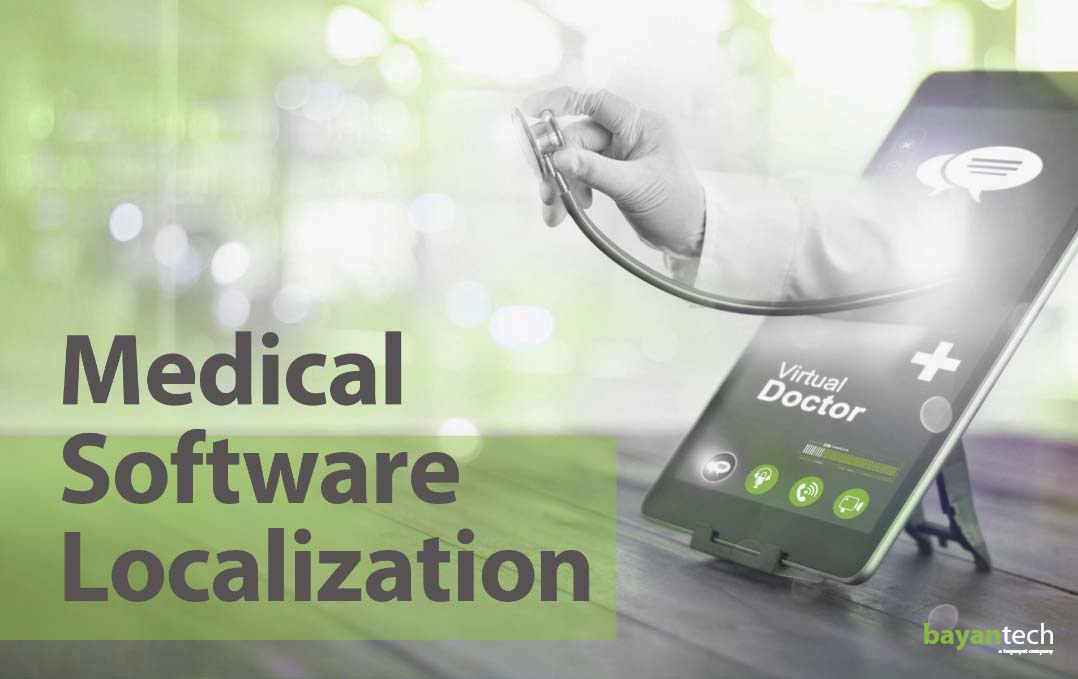Implementing healthcare technology at a medical facility can be an arduous process, requiring conscious planning and progressive implementation. And this already complex process can be made even more complex when the tools are in a foreign language, whether they’re medical devices, information technology platforms for healthcare management, or mobile apps for patients.
The medical field evolves and treatments are refined, and technology has to adapt to the ever-changing needs of both practitioners and those under their care. But this technological development isn’t exclusive to world-renowned research hospitals, or to the treatment of the most taxative medical conditions.
From the way we book a routine appointment with our doctor, to how X-rays are taken, all aspects of the medical field have undergone some degree of technological disruption.For international healthcare service providers to be able to use any of those tools, medical software localization is vital.
Well-localized healthcare products have the potential of reducing treatment costs, making preventive care more precise, and improving a population’s quality of life. Meanwhile, a poorly translated piece of medical software or a poorly translated manual can significantly reduce healthcare quality. When there’s so much at stake, precision is not optional.
In this post, we’ll dive into medical software localization and its particular challenges.
We’ll cover:

First Things First: What Is Medical Software?
A piece of medical software is a specifically designed tool that focuses on facilitating and supporting the day-to-day activities of medical professionals.
For instance, a piece of medical software may facilitate communication between the professional and the patient, ensuring the privacy and reliability of the data. These types of tools, known as Medical Practice Management software, replace the old school methods of handling patient information, such as paper records, spreadsheets, and computer software that were not designed to serve the healthcare industry specifically. They may also facilitate visualizing patient information and detecting trends. An example of this type of medical software is the open-source solution OpenEMR.

A medical center will probably rely on several tools to partially automate time-consuming everyday activities. For instance, medical software is often used to:
- Organize a patient’s agenda.
- Store and update medical records.
- Manage finances and calculate costs.
- Control inventories and resources.
Basically, to seamlessly manage the administrative dimensions of a medical center. These are a few among many other tasks that are difficult to carry if you don’t have a proper management system.
It’s also worth mentioning that medical devices rely on software to function. That software is often considered a medical device in itself. So, when you research medical software localization, it’s not uncommon to find the term “medical device localization” used almost as a synonym.
As important as understanding the potential of Medical Software, is understanding the importance of having it culturally and linguistically adapted. So, let’s take a brief look at how the software localization process tends to unfold.
Sign up to our newsletter to receive the latest blogs and news.
The Software Localization Process
Localization is the process of adapting a product to a particular market. Thus, software localization can be defined as the process of adapting a software product to a target market. The dimensions of the product that need to be localized, in this case, are the software itself and its documentation.
When doing business internationally, a medical device manufacturer (or medical software developer) may need to have other documentation translated. For instance, patents. But that’s another topic altogether.
The software will need to be adapted to run on the hardware that’s most common in the target region. It will also need to be adapted to match the linguistic, cultural, and professional conventions of the area.
Some of the elements that will be adapted are:
- The software interface’s layout
- Symbols, icons, and images
- Measurement systems
Of course, the foundation of any medical software localization process is a solid translation. All on-screen text must be translated to the target region’s language. Considering that a piece of software is not static, all the text in question has to comply with the standards of good UX writing. It must be:
- Precise
- Actionable
- Accessible

Any medical device documentation will have to be adapted as well.
All linguistic and visual elements have a denotative and a connotative meaning. When you localize a piece of medical software, it is essential that there are no connotations that may lead to user’s confusion. A small, and not so obvious, example is how the color red is normally attributed to a threat, but in China, red is associated with happiness. So, if the only way that an interface has to signal a threat is the presence of the color red, with no explanatory text, a localization team may have to change the warning’s color and add text to it.
From this example, you may deduce that localization is a cross-disciplinary effort. Simply solving this small problem would involve a developer, a designer, and a linguist. And at least one of them should have insider knowledge of Chinese culture.

But, how is this cross-disciplinary collaboration organized into a process that drives results?
The Medical Software Localization Process, Step by Step
These are the most common stages of the localization process:

Step 1. Initial audit and quote
The first step when approaching a software localization process is to define the scope of the work with your localization services company. You may need to set up meetings and explain what your goals and objectives are. Some relevant questions are:
- Which languages is the app going to support?
- Are you planning to expand to other markets later on?
- Who is the target user? Medical professionals or patients?
- What’s your target user’s specialty? Are you targeting dermatologists, big hospitals, or pharmaceutical companies?
- Is your product the software companion of a medical device?
- If the product is a mobile app, will app store optimization be necessary?
- Does your product have supporting documentation that should be localized as well?
- Are there any regulatory challenges?
All of this information will define how the translation and localization team will adapt the content, and how much time it will take. You should ask your LSP for a quote once you’ve defined clearly all your needs regarding the project.

Step 2. Source material analysis
First, the team must analyze the material to verify that all files have been received and that the product works. They must also determine which methods and resources are the most appropriate, to begin working.

Step 3. Translation and localization
This is often called the ”production stage” because it is the moment in which the localized material is produced. In the case of software, at this stage, developers, designers, and engineers will work to adapt the product’s interface, while the linguists work on translation. The engineering team will often rely on a practice called “pseudolocalization”, which involves creating hypothetical strings that don’t represent any language in particular, and testing whether the interface can adapt to them. Do containers break when the content gets longer? Do they look empty and out of place when the content is far shorter?


Step 4. Localization testing
Running tests on the localized software is essential to ensure high quality.
Software testing is a non-linear process that often involves returning to previous phases of the localization process. But it’s essential to ensure that the final product is error-free and fully functional.

Step 5. Quality assurance
Finally, quality assurance takes place. The aspects of the medical software to be evaluated are the same as in the previous checks, but with the difference that quality assurance doesn’t just focus on how the product runs, but also on whether it meets the strategic goals of the stakeholders. Quality assurance is most often conducted by a project manager, with a high-level, cross-disciplinary view of the project.
Every piece of the software, including the content and the interface design, passes through these stages of localization, which are essential to ensure a high-quality product. For consistency reasons, first, the localization of the software and the user interface takes place, and then the adaptation of any online help and documentation. Finally, the printed documentation is reviewed. This includes the instructions for use, user manuals, installation manuals, packaging, and labeling.

Key Medical Software Localization Challenges
Some technologies make it possible to partially automate translation work. And it’s not rare for translation teams to use the help of translation software that handles duplicated strings. But such precision and care are needed for medical software localization that it can never be completely delegated to machines. Machine Translation has not yet evolved enough to the point where it can fully understand the context and not make mistakes. To ensure a precise medical software localization, it is necessary to rely on a professional human translation team. Here are some medical translation tips to have in mind:
Subject-matter expertise: Medical localization should always be handled by high-quality software localization services with industry expertise. Otherwise, you’re risking improper terminology management. To provide software localization for healthcare, a company must have medical experts in its team.
Confidentiality: The documents that are subjected to medical translation are often sensitive. Protecting the patients’ privacy is a legal obligation of the healthcare provider and its partners. Hire a language service provider that has confidentiality procedures in place.
Precise terminology management: Consistent terminology handling is the king of medical translation tips. Even an experienced medical translator or technical writer can make the mistake of using terminology inconsistently. This may make a text unclear and, in the case of medical software translation and localization, make the tool less usable. Translation consistency is attained through the automation of repetitive tasks and the use of a glossary. We are not talking about merely translating a medical text, but a user interface that has to be easy to use, all content must be action-oriented and well-intentioned to be usable.

The importance of Medical Software Localization
In this post, we examined the main context of medical software localization, and how the process works.
The evolution of stem cell research and the implementation of artificial intelligence are just two of the numerous technological breakthroughs shaping the landscape of the healthcare industry. Because of this, a precise software localization process becomes critical in the medical devices industry. The delicate nature of healthcare and the complex technology involved in this field demands an extremely precise approach.
If you’re in need of medical software localization, look for a reputable translation agency that implements software localization best practices.
Medical software localization serves the function of making medical devices and interfaces easy for foreign medical professionals to understand and operate. After all, what defines our era is the outstanding economic development achieved by a globalized and interconnected society. This has become possible thanks to functionally integrated software as well as complex technological systems.
As we mentioned previously, the localization process is not merely the language translation of the product: it involves technology, culture, regulation, and usability. To prevent the process from failing, it is necessary to have high-quality healthcare software localization services that approach translation and localization thoughtfully and effectively.
At bayantech, we’re a localization and translation service provider with over 15 years of experience. We provide professional translation and software localization in over 260 languages. Our dedicated project management, strict quality assurance, and cutting-edge technology have made us the language partners of numerous leaders in the medical sector. From the Arabian Healthcare Group to the Mayo Clinic. Request a quote now, and start growing your user base.











